#spaghetti westerns as text posts
Text


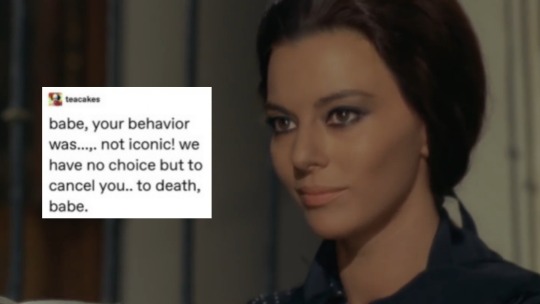




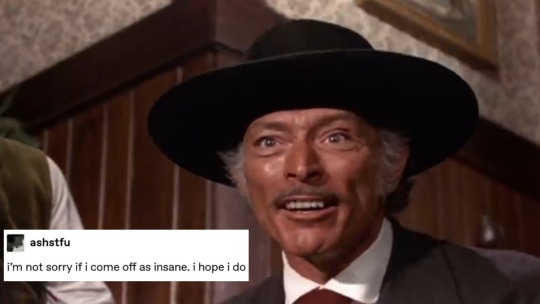


Spaghetti westerns as text posts 1/?
#the mercenary#il mercenario#a bullet for the general#quien sabe#the great silence#il grande silenzio#his name was holy ghost#uomo avvisato mezzo ammazzato parola di spirito santo#y le llamaban el halcón#sabata#ehi amico c'è sabata hai chiuso#è tornato sabata hai chiuso un'altra volta#return of sabata#spaghetti westerns#spaghetti westerns as text posts
49 notes
·
View notes
Text

Geneuary prompt Mermaid / Magical
People I can not tell you how happy I am with how this one turned out >w<
I'll be honest... I forget today was prompt day XD I didn't find out until I saw @golden--doodler post (beutiful drawing by the way)
And talking about golden doodler thanks her for this one cause I was actually not gonna post anything for mermaid XD for real I decided to let 2 prompt out for different reasons and this was one of them.
I didn't know what I wanted to draw on this one, magical was too general for my brain and mermaid was the one that caught my attention the most. But didn't know what I wanted to do with it.
But then golden made me think in the Little Mermaid, and Gene and Rudy been Little Mermaid fans, and they bonding over the Little Mermaid, and this practically drew by itself... and I had to add a jelous Louise, cause I have to.
Gene is always stealing his mans, first Bob and now Rudy XD (Spaghetti Western and Meatballs reference) (of of my fav episodes)
So yeah.
Did I color it this way cause I had short time? Actually no, which made me very proud.
I really envisioned like this, since I made that Jimmy Jr x Zeke piece (you youngsters say Jimmy Jr/Zeke) I wanted to do something similar... if you dont know about what drawing am I talking about thats alright is a little old 😅
But yeah, really like this one, could be my actual fav, if I do say so myself (see I do one nice thing and it goes straight to my head 🙄)
Oh and the text is in spanish cause this is from my childhood memories and as a child if I heard the smallest word in english I would burst into tears... I was englishfobic as a child. The irony.
#bob's burgers#bobs burgers#my art#geneuary2024#I swear to the gods#i didnt came out with this headcanon#I know I read Rudy been fan of the Little Mermaid cause of Pancakes in another post#I just didn't save it#T^T#but maybe the Gene part was actually on me#when I was 10 the Little Mermaid was my fav disney movie#my fav princess#I can not start telling you how obsess I was about mermaids#I name one of my ken's Eric for fuck sake#and this have become too much sharing#sorry#but yeah... im kinda proud of this one#and IS GENIE'S MONTH#but I actually had so much fan adding Louise to this piece 😅#Louise can be really jelousy over Rudy#she heard Rudy and Gene are having a sleepover to see the Little Mermaid#and she coincidentally doesn't have anything better to do then hang out in the living room with them#by the way I DO NOT SHIP RUDY X GENE#they're brothers#I actually love Gene being an older sibling figure for Rudy only child dinamic#My girl is just living too hard her fantasy#I can relate#I didn't mean to turned out romantic and I hope is really just me overthinking it#do I talk too much?#don't answer that
50 notes
·
View notes
Text
Why I decided to start a blog on Tumblr
Hello! This is my first post here. I don't know how to run a blog correctly, so I'll be learning as I go :) My English is not very good, so I'll be using a translator to write this text, so please don't scold me for mistakes, haha. Why did I decide to write in English? I'll start from the beginning.
I'm a big fan of spaghetti westerns! Honestly, I noticed that on Tumblr, they discuss classic westerns, there are posts, memes, artworks... There's so much content here, and I'm really happy about it!
Unfortunately, there's nothing like that in the Russian fandom. I've been unable to find people with whom I could discuss westerns, talk about how great Lee Van Cleef is in movies, how awesome Clint Eastwood is, what interesting characters and plots there are in various films, and so on. I'd be really glad if I could find friends in the English fandom with whom I could share my admiration for the Wild West in spaghetti westerns.
Thank you for reading this post <3

#westerns#wild west#cowboys#lee van cleef#clint eastwood#spaghetti western#i love them#dollars trilogy#the good the bad and the ugly
39 notes
·
View notes
Note
Do you have recommendations on where I can start researching classic samurai weapons and the martial arts that developed from their use? I'm kind of lost here.
It's not perfect, but The Book of Five Rings by Miyamoto Musashi is probably one of the better places to start. Musashi did have some eccentricities (most famously the practice of dual wielding the katana and wakizashi, which never saw widespread adoption), however he was mostly writing from the perspective of an instructor to his students, and because it's been preserved (and translated), it's a very useful and accessible resource.
Most importantly, Musashi provides insight into the mindset of the samurai, and while those do reflect his biases, they are still an excellent starting point, with a lot of very solid observations.
Beyond that starting point, you'd probably want to look into the relevant historical period of Japan. There isn't a single reference to cite, because it could be literally any piece of history. However, a quick overview (even from Wikipedia) should get you pointed in the right direction for history texts.
While it's a bit more fantastical, and not a traditional read, I'd be remiss if I didn't mention Akira Kurosawa's filmography. I'm partial to Yojimbo (1961), but he directed many classics. If you need to pick one, Seven Samurai (1954) is probably the one to watch. And if you find yourself thinking, “this reminds me of Star Wars for some reason,” there's The Hidden Fortress (1958.) Really, Kurosawa directed a lot of excellent films.
It is worth remembering that Kurosawa's depictions of the samurai were often subverting the cultural veneration they enjoyed, and in some ways he's analogous to the spaghetti western's demystification of the American cowboy. This is part of why so many of his films have been remade as American westerns (including Yojimbo, and Seven Samurai.) This made Kurosawa a controversial director in Japan, though, he does offer a very distinct perspective on the Samurai.
-Starke
This blog is supported through Patreon. Patrons get access to new posts three days early, and direct access to us through Discord. If you’d like to support us, please consider becoming a Patron.
106 notes
·
View notes
Text
Composite Super-Weeds from Hell: An Analysis of Flower Language in Chainsaw Man
Once upon a time, I started noticing the flowers in Chainsaw Man. Then, I couldn’t stop noticing them. 1 trillion open tabs later, and here we are. I must share my sickness with the world. Is every last plant in this manga meaningful? Probably not. Are at least some of them meaningful? Absolutely. So, I'm throwing the entire pot of spaghetti at the wall, and seeing what sticks. A few things to note before we start:
Color is a crucial aspect of flower language, but can be rather ambiguous in Chainsaw Man. I’ve heard tell, for instance, that the coloring choices on the backs of volume covers, those in the anime, as well as the official colored re-release of Part 1, were not overseen by Fujimoto himself. Case in point: at the café where Reze works, there’s a decoration featuring dried stalks of grain which the colorists seemingly mistook for lavender and colored purple. As such, I’m going to ignore any color choices that I’m not 1,000% sure Fujimoto was responsible for, and will use only his colored illustrations and choice of screen-tones as a guide.
I’ll be primarily using hanakotoba, rather than Victorian floriography, as my guide for meaning. However, it’s worth noting that the vast majority of Japanese-language hanakotoba compendiums I’ve seen online will also list western interpretations of a given flower alongside Japanese ones, so those wouldn’t exactly be obscure information in Japan.
I wish I could add way more reference photos to this. Alas, tumblr has an image limit.
I’m going to be saying the following words a lot, so here’s a note on terminology: ray florets refer to the “petals” of Asteraceae flowers—each of which is actually its own flower, disk florets refer to the tightly clustered, bud-like flowers that make up the central disk of Asteraceae flowers, and ‘flower head’ referrers to the entire inflorescence of an Asteraceae.
This undertaking quickly became. huge. So, in the interest of not dumping an entire brick shithouse of text on my potential readers, I’m dividing this in half, and will only be analyzing the plants of Part 1 here. I’ll post about Part 2 at a later date.
With that, let me begin by talking about the flower which I believe represents the Hayakawa family.
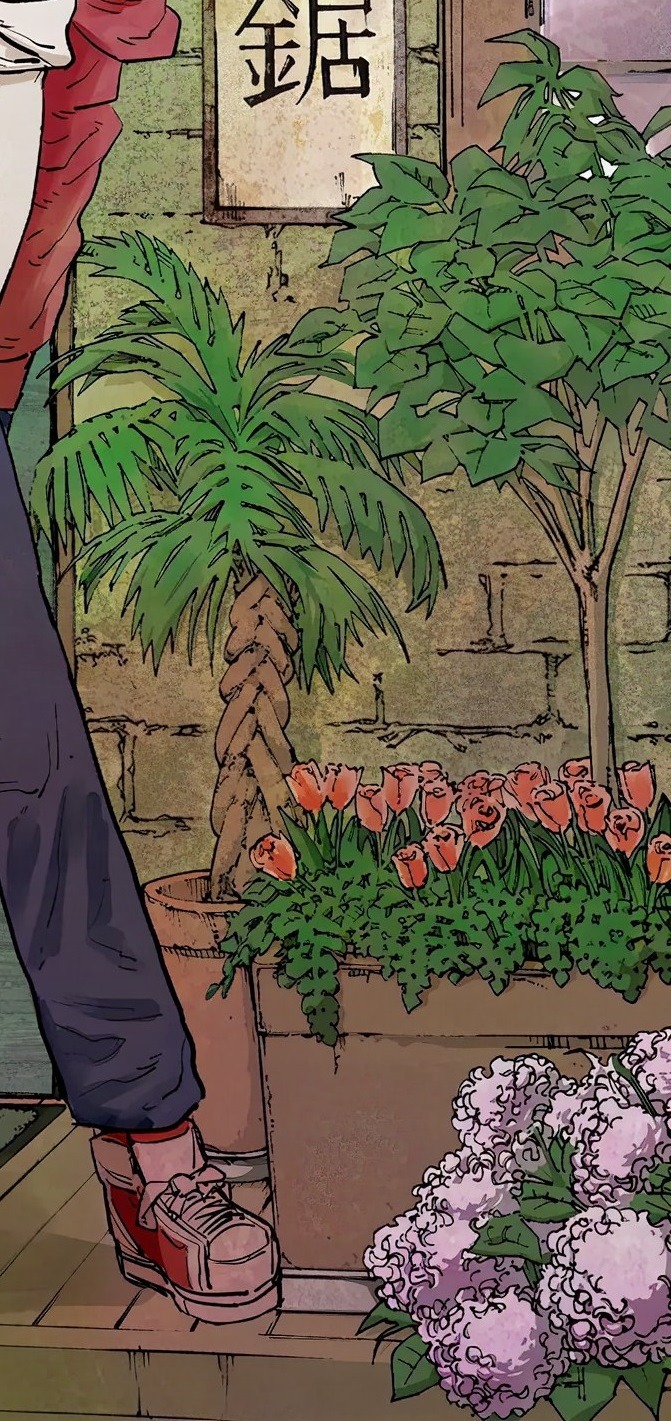
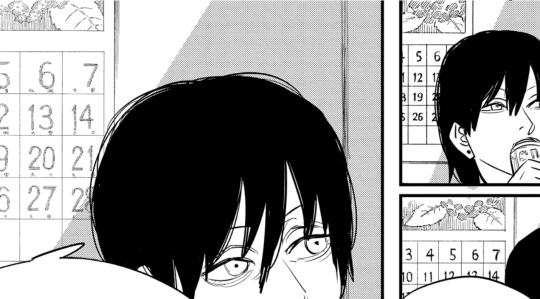
Hydrangeas appear twice in Chainsaw Man. First, on the cover for chapter 15, as Power hangs off of Denji while they pose for the camera and, second, on the calendar in chapter 72, as Aki comes to the realization that he loves Denji and Power more than he desires revenge. They have a number of meanings in Japanese culture, many of which are actually rather negative. Unlike the camellias that will appear later in this analysis, or the ever-famous cherry blossoms, hydrangeas don’t lose their flowers in a poetic or melancholic fashion. Rather than falling or wilting, the flowers simply dehydrate, lose some of their color, and shrivel up on the stem, where they will remain until winter forces them to yield. As such, it’s apparently common practice to prune them before they can get to this point, so as to ensure a heavy bloom for the next season. Because of this tendency to overstay their welcome, and become unsightly as a result, they are associated with stubbornness, haughtiness, and callousness. You can also add ‘fickleness’ to that list of negative connotations, due to their coloration and blooming period. When and how much they bloom is contingent on the vicissitudes of annual rainfall, if there isn’t enough, you’ll have a lackluster season, if it comes early or late, so too will the blooms. Because the anthocyanins that provide its pigment are sensitive to acid, its color will also vary with whatever soil it’s planted in, and a shrub already in bloom will even shift color over the course of a season. To the groundskeepers and gardeners of Japan, it seems that the hydrangea is a stubborn, cantankerous asshole of a flower—not that we would ever use those adjectives to describe the leads of Part 1.
There are, however, a handful of positive meanings ascribed to hydrangeas in Japan, such as tolerance, ‘heartfelt gratitude,’ and ‘patient love.’ For our purposes though, the most crucial of these is that the tightly clustered arrangement of its flowers is seen as a symbol of harmony and family bonds. Taken together, these meanings paint a picture of a tight-knit family of prideful shitheads who are subject to the fickle whims of rainfall and soil fate, all wrapped up in a single flower. I don’t think I could have picked a better symbol for our doomed trio if I tried.
Something else worth noting are the other plants that accompany the hydrangeas in the chapter 15 color page. While I can't tell what the tree on the right is, the other two plants are pink tulips and a palm tree. In hanakotoba, pink tulips represent ‘budding love,’ affection, and ‘true love.’ This chapter comes soon after Denji’s disappointing boob-fondling, which was the first step on his journey towards realizing he isn’t attracted to Power, that it’s possible in the first place to relate to women in ways other than sexual or romantic attraction, and that he loves her as a friend. So, alongside the hydrangeas, the combined meaning of these flowers seems to be: “These two, (who are assholes btw,) are starting to love each other as a family.” Palm, meanwhile, means 'watching over you,' 'firm determination,' and success. If we're meant to also derive meaning from the tree as well as the flowers, it almost feels like foreshadowing of Power's role towards the end of Part 1, of how she protects Denji even in death, and is ultimately the one to tip the scales enough to allow him to prevail over Makima.
One last thing: as I alluded to earlier, hydrangeas are heavily associated with Japan’s rainy season, which spans early June to mid-July, and June is the month that the fantastical family photo from chapter 79’s color illustration is dated to. I dove into this in excruciating detail in one of my metas regarding the dates and calendars that appear in Chainsaw Man. Please, do give it a read if you get a chance. More people need to know of Fujimoto’s shenanigans. (Ignore my flower language analysis in that essay, though. I was young and green. I mistook ‘fickleness’ for ‘impermanence’ like a rookie, like a chump!)
With hydrangeas as our baseline, I’d like to talk about a more recent addition to the list of flowers. I know I said I’d only be looking at Part 1 flowers in this essay, but there’s a certain aspect of this flower’s portrayal that’s very important to keep in mind going forward regarding how Fujimoto uses flower language.

These flowers in the stained-glass are Platycodon, also known as kikyou, also known as balloon flowers, also known as Chinese bellflowers. Given the use of a medium screentone, they’re probably the standard purple variety, rather than white or pink. At least, they ought to be balloon flowers. From the downturned blooms, to the alternating arrangement of the lanceolate leaves on the stem, to the shape and curvature of the petals, and even the screentone, everything matches. However, the flowers on the door have six petals, whereas balloon flowers only ever have five. As a matter of fact, much of the symbolism associated with balloon flowers comes from their five petals. As far as I could dig up, only one member of Campanulaceae has six petals: the Canary Island bellflower. But, its leaves are a completely different shape than those in the illustration. In addition, it is a vine that doesn’t stand upright on its own, again, unlike those pictured here.
So, it’s definitely a balloon flower, and given how much their five petals play into their cultural significance, I highly doubt that the sixth petal is a result of mere oversight. My takeaway from this is that Fujimoto is willing to, at times, fudge botany for the sake of making some artistic point. Going forward, whenever we encounter a flower that doesn’t exist, isn’t blooming in its proper season, or has something otherwise off about it, we need to ask ourselves: what’s the rationale behind this? With regard to the balloon flowers specifically, my thoughts are as follows: in China and Japan both, the five petals of a balloon flower are taken to symbolize the five elements of Taoism, as well as the five senses. If you’ll recall chapter 84, Makima claims that humans used to have a sixth sense before Pochita ate its corresponding devil. Perhaps this sixth petal is a vestigial remnant of that bygone reality. That’s the best I can come up with for now, in any case. I doubt we’ve seen the last of it, and I feel our understanding of this mysterious six-petaled balloon flower will evolve with time.
Now, onto the more sentimental meanings of the flower: ‘undying love,’ sincerity, grace, and—get this—‘longing for a friend’s return.’ The fact that this flower adorns the door that ushers Denji both in and out of hell tells me that it’s reflecting his emotions. A few chapters earlier, Denji lobotomized himself in order to avoid thinking about Power and Aki, but then started rambling about French dogs, a street food specific to Hokkaido, which he probably ate with them on their trip. And, in this moment, Denji seemingly spirals into despair at the prospect of not getting laid, but promptly falls through a door which loudly proclaims ‘I love and miss my friends’ in flower language. Ouch.
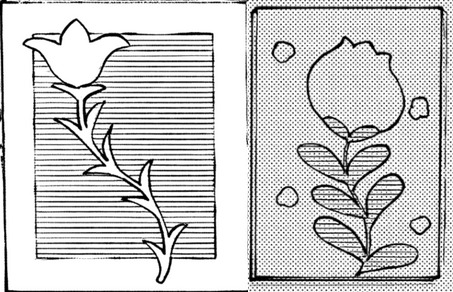

Something else worth noting is that the balloon flower makes two other, subtler appearances. It can be seen on two panels of the stained glass on volume 14’s cover, as well as in the café where Yoshida brings Denji and Fami. However, neither of them are the traditional blueish-purple color. Those on volume 14’s cover are definitely white, while the graphic design in the café is simply screentone-less, and thus, could be either white or pink. White balloon flowers mean ‘neatness’ and ‘obedience,’ and pink balloon flowers symbolize misfortune. Given how Famine is manipulating several different factions, and the fact that the café is where Yoshida invites those difficult personages whom he is trying to bring to heel, I think it’s safe to say that they’re both white, and that white balloon flowers are being used as a symbol of social control. One color stands for the jackboot stomping down on our characters, while the other stands for the love that makes all the drudgery and indignity worth fighting through. I wonder if these two versions of the flower will be directly contrasted with each other in the future.

Another nonexistent flower appears in the very first chapter. It appears to be some sort of thistle… which is also a parasitic vine? After much googling, I’m pretty sure that no such plant exists. The closest I could find was the broomrape family, but their flowers look nothing like the one in the illustration, and as far as I can tell, they doesn’t predate on trees, only other herbs. The meaning of a parasitic vine is quite obvious in context—Denji is asking Pochita to live on through him—but the flower itself has something to say as well. Thistle mean independence, ‘don’t touch me,’ and retaliation in hanakotoba, alluding to both the harsh austerity of Denji and Pochita’s lives up to that point, as well as their scrappy determination to keep living.
Now that we’ve talked about some quasi-unreal flowers, let’s look at some examples of Fujimoto using flower language ironically, starting with Himeno, and the many flowers which adorn her stretch of the story. While the centerpiece is undoubtedly the chapter 25 cover page, we’ll first need to delve into some other flowers to fully appreciate it, starting with bouquets she left on the graves of her old partners.
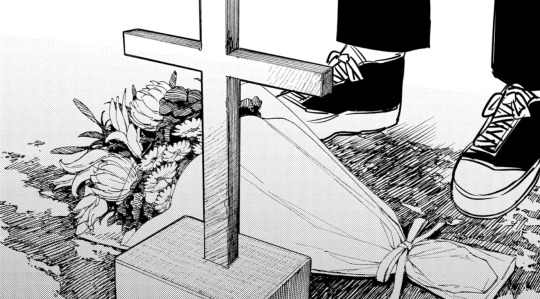
To my eyes, these bouquets seem to contain white chrysanthemums and Easter lilies. I’m going to take an educated guess and say that the daisy-like flowers are calendulas, based on the size of the flower heads, as well as their distinctive cup-like shape. All three of these are very common as funeral or sympathy flowers, with the white of the first two representing a return to purity through death, and calendulas in general meaning grief, mourning, and ‘the sadness of parting ways.’ All in all, appropriate choices for a somber occasion.
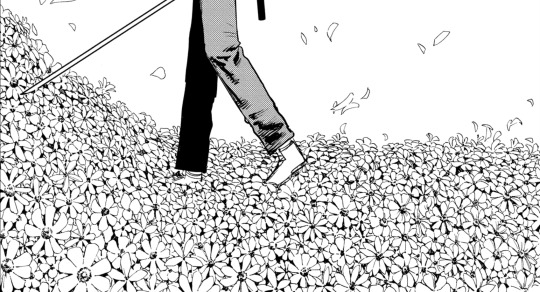
The flowers on the Ghost Devil have between 5 and 12 pale petals. Said petals are sometimes thin and pointy, but at other times, broad and bluntly-tipped. The centers seem dark at a distance, but are more variegated in close ups. All of these characteristic remind me of the many species of wild anemone; in fact, there are patches of them growing near where I live that look almost exactly like these. Anemones are associated with death, sickness, and forsaken love; all quite appropriate for the Ghost Devil.
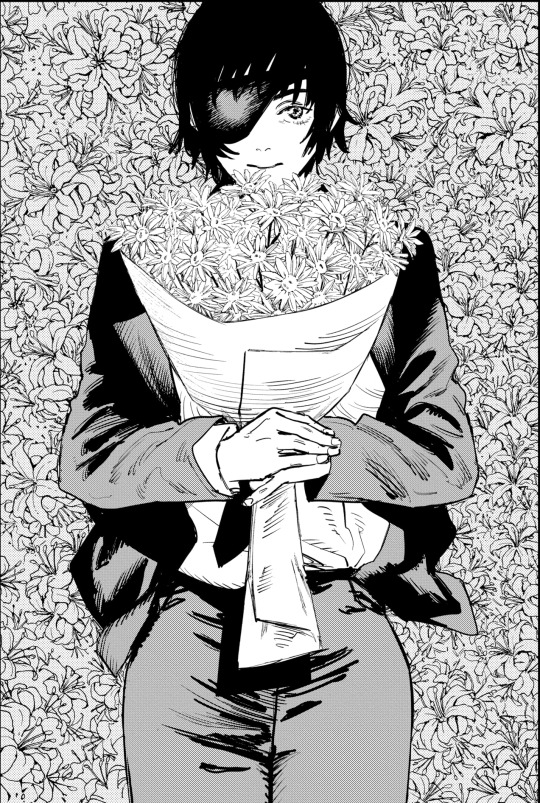

Keeping those in mind, let’s look at that chapter cover, starting with the more straightforward flowers to identify: those of the background. Upon first glance, I figured they were Easter lilies—which would fit; as I mentioned, they’re a common funerary flower. But, if you look closely, you'll note that the flowers are clustered together in little radiating bunches reminiscent of spider lilies. (Although the stamens aren’t nearly long enough for those to be a possible match.) Consider also how the petals are bent slightly further backwards than those of the typical lily. I believe these are actually Lycoris squamigera, known as surprise or resurrection lilies in English, and natsuzuisen in Japanese. In hanakotoba, they have the following meanings: ‘I would do anything for you,’ 'heartfelt fun,' 'sad memories,' and 'deep compassion'—all of which, in my mind, line up with Himeno’s feelings towards Aki, while also expressing that she’s about to sacrifice herself for him.
Now, onto the flowers in her bouquet. They have broad, flat central disks, large flower heads, and small, sparse, spatulate stem leaves with an alternating arrangement. After much waffling, I determined that they are most likely to be Leucanthemum, either oxeye or Shasta daisies, which have the following meanings:
Leucanthemum vulgare/oxeye daisy: patience, generosity, tolerance, sorrow, innocence
Leucanthemum × superbum/Shasta daisy: patience, endurance
It’s also worth noting that the broader, non-botanically-specific meaning of daisies in hanakotoba is ‘faith.’ I think that could work as well, considering that, in this scene, Himeno is taking it on faith that Aki will live on and mourn her. The meanings along the lines of patience, tolerance, and endurance could also allude to how Himeno has stuck with Public Safety, which she no longer wants anything to do with, which she knows will be the death of her sooner or later, for the sake of watching over Aki. ‘Sorrow,’ I believe, speaks for itself. But, I think the meatiest reading of this bouquet can be discerned by taking a step back, and considering it in the context of those other flowers I just talked about.

Leaving aside the specificity of flower language, daisies in general are regarded as fun, cheerful, innocent, and kind of juvenile—which is why they aren’t exactly mainstays of sympathy arrangements. I think the choice to give Himeno a funeral bouquet of daisies after making a recurring motif of more proper mourning flowers is meant to express an irreverence towards the supposed solemnity of death, especially as it relates to Public Safety grinding their foot soldiers into paste. The reality of their circumstances, of the system that is killing them, renders the sentiment of all those ‘mums, lilies, and calendulas hollow, inadequate, and trite. Thus, a blatantly inappropriate flower better conveys the tragicomedy of their lives. Much like how the puerile dick-kicking was Himeno’s requiem, a funeral arrangement of fun-loving, pink surprise lilies and blithely cheerful daisies is a middle-finger to the conveyor belt of death that all devil hunters are strapped to, one final testament to her flippancy and defiance.

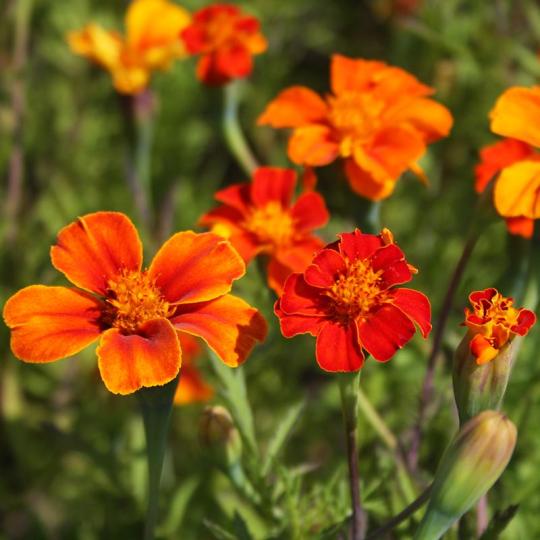
Another instance of ironic flower language can be found in Reze and Denji’s flower. This one frustrated me for the longest time. At first glance, you look at it and think: oh, a daisy, and fill in the blanks with young love, and innocence, and so on, and so forth. That’s not a daisy, though. Daisies have between 15 and 30 ray florets. This one has twelve, at the most. I say ‘at the most’ because, not only do the flowers that Reze and Denji receive at the beginning and end of the arc have a different ray floret count from each other’s, the number of ray florets on the same flower shifts from panel to panel. In the panels where they’re clear enough to count, Denji’s has 12 is one panel, and 10 in another. Reze’s has 9 in one panel, and 7 in another. And to top it all off, Denji’s flower only has a screen tone in its second set of panels, not the first. Maddening. Amorphous color-changing daisy that exists to spite me. I spent about a week counting and recounting the ray florets, hoping they’d eventually make sense. But, it was only when I gave up, and decided to ignore Sherlock Holmes and the Case of the Shifting Ray Florets, that I made any headway in identifying this mystery Asteraceae.
Observe Denji and Reze’s flowers, and compare them to those seen in the cover illustrations for chapters 25 and 49. While the latter have a multitude of skinny ray florets, the former have fewer, broader ray florets. This, I think, rules out daisies, asters, calendulas, and chrysanthemums—which narrows it down to cosmos and coreopsis, as well as the more sparsely arrayed wild variations of marigolds, zinnias, and dahlias. After much thought, I concluded that the most likely candidate is wild marigold—probably either Tagetes patula or Tagetes erecta. Note the bulbous growth just below the flower head; in botany, that’s called a receptacle. Of the plants I’ve mentioned here, marigolds and zinnias are the only ones with a similar shape to Denji and Reze’s flower, having a long, thick receptacle—which, unlike the ray florets, is drawn consistently in every panel featuring this flower. In the other plants I’ve mentioned, however, the receptacle is petite, stout, or both. If you look at the upper right of Himeno’s bouquet, you can see an example of that more typical shape. Anyway, between marigolds and zinnias, the former is most likely because the flower in the illustration lacks the zinnia’s distinctive, variegated disk florets.
Now that we’ve solved the mystery of its taxonomy, let’s move on to the subject of its meaning. In hanakotoba, marigolds represent despair, grief, and jealousy. I suppose it’s fitting that the group raising funds for orphaned children chose a flower associated with death and mourning? Beyond the diegetic explanation, I like the dissonance of using such an ominous flower as the emblem of Denji and Reze’s cute-but-doomed puppy love. It’s the irony of Himeno’s daisies, but from the opposite direction, with both, I think, displaying a similar devil-may-care attitude. We’re doomed, but we might as well make merry about it.
Given the use of a medium screentone, I also suspect that this is an orange marigold, rather than a yellow one. Orange marigolds in particular mean ‘prophecy’ in hanakotoba. If this additional meaning is intended, perhaps it relates to the fact that this story arc is a closed circle that begins and ends with the same flower. I also wonder if there’s significance to the fact that their flower is a wild marigold, rather than the more recognizable, heavily-bedecked, hybridized version. I take it as an allusion to the fact that Reze’s feelings for Denji were, ultimately, sincere and spontaneous, despite all the cold artifice that initially brought them together.
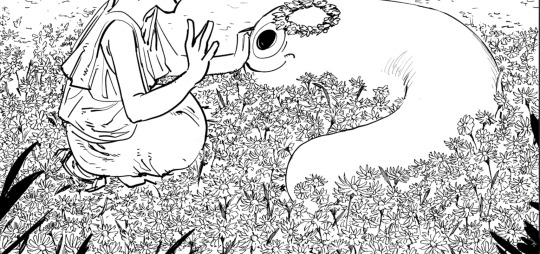

A third example of ironic hanakotoba can be found in chapter two, in the field of flowers where Denji finds the kidnapped girl. Judging by the size and conical shape of the flower heads, and their rotund central disks, I believe that these are asters from the Kalimeris family. While there are several native to Japan, yomena is the most well-known and ubiquitous. In hanakotoba, it means obedience and ‘hidden beauty,’ with the name itself meaning something along the lines of ‘bride’s greens.’ While the yomena’s name and meaning are surely intended as a paean to demure and submissive femininity, here those associations are cast in a definitively negative light: the girl is hidden because she’s been kidnapped, and obedient because her body has been made into a puppet. In my research, I actually found quite a few flowers that had meanings along these lines, and I must say that it’s very Fujimotocore of Fujimoto to either deftly avoid those flowers, or twist their meaning into something sinister, as with the yomena and white balloon flowers. Truly, this man loves mean, domineering women with his whole chest, and recoils from anything to the contrary.
Now that we’ve established that Fujimoto likes both irony, and making up flowers, let’s do hanakotoba in hard mode. We’re going straight to hell.



See this thing? This gave me the most trouble out of any flower here. It’s a basal clump of sword-shaped leaves, with one or more five-petaled flowers emerging from the ends of leafless stalks. Primrose? No. Hellebore? No. Anything Ranunculaceae? At all? Please! It looks so much like a buttercup! No. Is there perhaps a species of crocus that happens to look like buttercup? No. Pentas? No. Babiana stricta? No. Phlox? No. Dianthus? No. Nemophila? Also no. This went on for several weeks. If it were just some random flower drawn to take up space in one or two panels, I wouldn’t have tried so hard. But, the ground in hell is copiously littered with these things; they literally extend as far as the eye can see in any panel where the ground is visible. Rather than being drawn as an afterthought, it seemed instead that extra attention was being paid to the details of the plants throughout the hell excursion, so it galled me that I kept hitting a wall whenever I tried to identify this mysterious flower. It’s as if those hyper-detailed close-ups of dandelions in chapter 63 were a thrown gauntlet, daring me to identify the flowers that would appear soon thereafter. In the end, the closest real-world analogue I could find was the plantainleaf buttercup, a wildflower native to the mountainous regions of western North America. But, even aside from being pretty obscure in Japan, it still doesn’t perfectly fit, as the flower in the hell chapters has no stem leaves at all, whereas the PLB does.
About the time I started going crazy, about the time I started wondering to myself: “What if, down in hell, oleander is an herbaceous wildflower instead of a tree?” I was forced to admit that—much like the six-petaled balloon flower, much like the parasitic thistle-vine, this probably wasn’t strictly a real plant. After admitting defeat in that arena, I finally hit a breakthrough when I started thinking about the mystery flower in the context of the few other plants to be found in hell. There’s a dandelion, a rosette-shaped weed of some sort (probably broadleaf plantain,) along with what I believe to be several cosmoses (more on those later.) All three are hardy, fast-growing, weedy, and a common sight in poor-quality or otherwise disturbed soil, and I figured this mystery plant was likely to be in the same category. I started looking up common weeds in Japan, and found three that were very close to the mystery flowers in one aspect or another. The flowers in question are spring starflower (Ipheion uniflorum,) blue-eyed grass (Sisyrinchium rosulatum,) and creeping woodsorrel (Oxalis corniculata.) I’ve come to believe that the mystery flower is actually an amalgamation of woodsorrel and one of the two other plants. Its flower looks exactly like the woodsorrel’s: small, pale, and delicate, with five petals that have a blocky, rectangular character. The stalk it emerges from could belong to either of the other two I just mentioned, as I couldn’t completely rule either out. Both are basal clumps of sword-shaped leaves, with flowers emerging from the ends of upright, leafless stalks. Hell, it would seem, is a big empty lot full of composite super weeds. Two weeds for the price of one.
When you view this combo through a hanakotoba lens, it gets very interesting, especially if you assume that the base of the plant is spring starflower. That one means ‘a sad farewell,’ despicableness, ‘enduring love,’ and resentment. As for the woodsorrel, it means joy, ‘shining heart,’ and ‘a mother’s love.’ If you combine the two together, I interpret the resulting alchemy as ‘an awful betrayal at the hands of an idealized maternal figure, one you can’t help but love anyway.’ A sweet, cheerful flower lounging atop a base of trauma, ambivalence, and abuse. Is that not Part 1 in a nutshell?

It gets even juicier if we zero in on the meaning within just the context of this scene. While these starflower-sorrels extend as far as the eye can see from chapter 64 onwards, they’re actually barely present for our first glimpse of hell at the end of chapter 63. What’s more, they’re nowhere to be seen in hell during the Falling Devil arc. I posit that they emerged to reflect Tolka’s feelings of fresh betrayal and terror at the hand of his mother figure, and came to dominate the landscape as his doom approached, and the gravity of his situation set in.
As for blue-eyed grass, though: prosperity, ‘rich emotions,’ and ‘a lovely person.’ Kind of boring by comparison, not spicy, not juicy, not a metaphor of Part 1’s themes of abuse. Count me as a starflower-sorrel truther. I suppose I should also talk about the dandelion too. It's associated with the whole fortune-telling, make-a-wish thing, but it also means 'pure/sincere love' and separation. Maybe the hanakotoba is relevant, or maybe the dandelion is just there to set up the vibe of a weedy, vacant lot. If the former is true, then my read is that it--like the starflower-sorrel--is reflecting Tolka's emotions in the moment.
There’s another flower seen in hell which I’ve only briefly mentioned. Much like the character who’s named after it, it’s more significant than a first impression might have you believe.

Cosmos—Greek for orderly arrangement—is a flower that earned its name from its ray florets: always 8, and always uniform in size and length. Its use in Chainsaw Man draws upon its meanings in both hanakotoba and floriography. On the one hand, it means love, sincerity, purity, affection, and modesty, and on the other, the order, harmony, and beauty of the universe, and these dual meanings are embodied in the character of Cosmo. (Well, maybe not the modesty part.) But before I get ahead of myself, let’s set this flower’s fiendish mascot aside for a moment, and look at the panel where cosmoses actually show up.

Ignore Violence’s leg being on the wrong layer, and take a close look at the field of flowers. In the background, we can see what are most definitely cosmoses, with each concave flower head having 8 large, toothed, evenly-spread ray florets, with thin stems, and a small central disk. Looking at the foreground, though, things have gotten a little weird. The overall shape of the flower heads is the same, and they still have the distinctive silhouette of a cosmos, but there are only 5 or 6 ray florets on each flower. Finally, on the far right of the panel, in extreme close-up, are the five rectangular petals of creeping woodsorrel, and you can even see that its petals have a slight downward-curve, as opposed to the upward-curve of all the other flowers. After this panel, the cosmoses disappear, and there are no other plants to be seen in hell aside from starflower-sorrel. I believe that what this panel is depicting is the moment that the plants of hell transform to reflect Tolka’s fear and despair. The cosmos flower, then, is a representation of the neutral fabric of existence, which is acted upon by human emotion to create to a new, fantastical lifeform that defies of the laws of nature. In other words, these background plants are a synecdoche of Chainsaw Man’s main world-building conceit, representing both devils, and the human fear that brings them into existence.
Both here, and in Cosmo’s displays of fearsome power, do we see the cosmos flower’s association with order and harmony put in a menacing light, for the order and harmony that upholds Chainsaw Man’s universe is inscrutable, hostile, and unforgiving. But, there’s a silver lining to all this that is, again, exemplified in Cosmo herself. A while ago, I read a meta on Cosmo, which speculated as to the true nature of her character, and what the whole Halloween thing was actually getting at. You should totally give it a read, but to surmise, this person posits that Cosmo, having gained knowledge of all things, understands that the best remedy to the cruel farce of existence is to have fun, be yourself, embrace your spookiness and imperfection, and spend your finite time alive having gay sex being with your loved ones. I pretty much 100% agree with this person’s take. Why do you think she has big, heart-shaped pupils? It’s because she’s seen the truth at the center of the universe, and it is love. Love and sincerity—as codified by cosmos’s meaning in hanakotoba.
There are a couple of other possible connections regarding cosmoses that are more tenuous, but which I still wanted to make note of regardless. The flower’s most well-known characteristic is its 8 ray florets, and ‘8’ is a number that has shown up quite a few times in Chainsaw Man. When the cast is trapped by the Eternity Devil in Part 1, the clocks are stopped at 8:18, the Future Devil is housed in cell 108, and the number 108087 kept cropping up in the background Where’s Waldo-style earlier in Part 2. There’s also an ‘8’ on Yoru’s bread bag. Not sure what that last one’s about, but, bread aside, the numeral keeps getting used as a symbol of, I want to say… the mysteries of the universe? Probably because ‘8’ is the infinity symbol tilted 90°. The last thing I want to note is that it’s possible Cosmo isn’t the only one of Quanxi’s fiends to be named after a flower. ‘Hagi’ is Japanese for bush clover, which, like the cosmos, is a flower that blooms in autumn in Japan.
With that, we’ve gone over most of the big ones, but there’s still plenty more to talk about. Let’s start with Quanxi’s herb garden/tree nursery/vineyard. I’ve numbered the plants more or less in order of how sure I am in my identification, so let’s go down the list:

The lovely metalwork here on the fence helpfully clues us in that these are grape vines, rather than, say, ivy or morning glory, which can have similar looking leaves. Because of their association with wine, both the fruit and the vine mean ‘euphoria’ and ‘oblivion’ in hanakotoba. This is likely alluding to the fact that she’s having sex pretty much any time she isn’t working, as well as her philosophy of turning a blind eye towards any information which would make her unhappy.
At first, I thought these were pines, which would work, don’t get me wrong. Pines are associated with renewal, endurance, and longevity in Japanese culture—a fitting symbol for the character who’s implied to be the oldest hybrid. But, after some additional digging, I determined that the overall shape of the plant was much more in line with rosemary. In hanakotoba, rosemary means faithfulness and ‘unchanging love.’ I see this as a counterbalance to the unsentimental hedonism implied by the grapevine, which is probably why these two plants are the ones that most dominate the frame. Indeed, Quanxi loves two things: escapism, and her girlfriends. Or, maybe the presence of rosemary just means she eats a lot of potatoes, and needs two big bushes worth of rosemary to season them with.
I believe this is yucca, though I had also considered that it might be aloe or snake plant. However, we see aloe in Part 2, and care was taken to draw it with the little spines on its leaves, which this plant does not have. Snake plant usually has stripes or banding, and sparser, wavier leaves in a less orderly arrangement. So, I ruled that out too. In hanakotoba, yucca means ‘dashing’ and ‘brave.’ I think that speaks for itself; she’s quite the badass.
Much like the yucca next to it, I believe this is also a young tree. The shape and arrangement of the leaves look very much like plumeria to me. Plumeria means elegance, sunshine, ‘blessed person,’ passion, and ‘shy maiden.’ My interpretation is that this plant is an ode to her girlfriends.
Here we see dense clump of serrated, rhomboid leaves. I think this is mint, which means ‘efficacy’ and ‘virtue.’ Now, I don’t think Quanxi cares about virtue one way or another, but she sure is effective and efficient! Fujimoto told me she always keeps fresh mint on hand in case she or her girlfriends want mojitos.
I thiiiink this is bay laurel. This one has a dual meaning, as the plant in general means glory, victory, and honor, while the leaves on their own mean “I will not change ‘til the day I die.” That last one reminds me of how Kishibe describes his feelings for Quanxi in Buddy Stories. He loves her because she’ll never die on him, and because their relationship will never become close enough to beget the risk of true vulnerability. Also, she uses these for soup.
Overall, I find this array of plants to be curious, and quite different from others that have shown up before this point. Her setup has one decorative flower that isn’t blooming, a grape vine which hasn’t borne fruit, and three trees which are residing in flowerpots instead of the earth. I’m not sure what to make of it, but it feels like there’s a dissonance being implied here. Much to ponder… Anyway, speaking of vines:


The cover of volume 3 is full of five-lobed green leaves which are closely clustered together, making me think they are ivy. In hanakotoba, ivy means ‘eternal love,’ marriage, friendship, faithfulness, and immortality. I think their presence here is alluding to what Himeno wants, but can’t attain: a long life together with Aki, outside the clutches of public safety. The fact that the ivy is overlaid on top of her gives a dreamlike quality to the illustration, adding to the idea that the ivy is standing in for that which Himeno fantasizes about. Back to Reze:

Reze’s kimono here on the cover of chapter 49 tripped me up for the longest time, because I at first assumed that its design must be depicting the same flower she received from Denji; but as we’ve established, that can’t be the case. The colors don’t match, and neither do the size and shape of the ray florets. That was a marigold, and these are daisies. While I’ve already talked at length about daisy symbolism, there’s actually one more aspect to it that I haven’t brought up yet, one specific to Bellis perennis and Argyranthemum frutescens—the common daisy and the marguerite. The schoolyard game of plucking the flower to determine if your crush likes you has made its way into the hanakotoba of those two varieties, and they thus have meanings such as ‘oracle of love,’ ‘fortune-telling,’ and ‘secret love.’ I think this might be the most relevant interpretation to this illustration, as it alludes to the ambiguity of Reze’s true feelings towards Denji. She loves him, she loves him not…
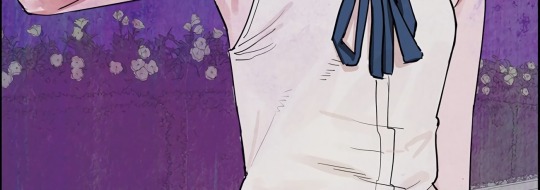
On the cover of chapter 46, we have a medium-sized shrub with dark leaves and large, white flowers. There are a number of plants which could fit that description: gardenias, magnolias, roses, camellias, etc. At first, I was having trouble ruling anything out. But then, I remembered that in this moment, Reze is beheading herself. Duh, of course those are camellias. Later, I noticed a leafy stem sticking out on the far left of the bush that confirmed my assumption.

The leaves of a rose do not grow directly off of the branch which sprouts the flower, but from small, offshoot stems, unlike the plant pictured here. Gardenias, meanwhile, have a whorled leaf arrangement, with three or more leaves radiating in different directions from a single point—again, unlike those pictured here. Magnolias have a similar leaf arrangement to camellias, but they don’t have the large volume of petals that the flowers in the illustration do. So, these must be camellias.
Camellia japonica is associated with samurai, Edo period nobility, and honorable death. This is on account of the life cycle of their flowers. They fall off whole, and in the peak of their bloom, rather than gradually wilting as most others do. White camellias have an additional meaning of ‘waiting,’ which fits when you consider that this image depicts the tense standoff that precedes Reze’s massacre. But, beyond that, I also interpret the use of white camellias, rather than the more-iconic (and decidedly romantic) red ones, as a sign that Reze and Denji’s romance isn’t meant to pan-out.
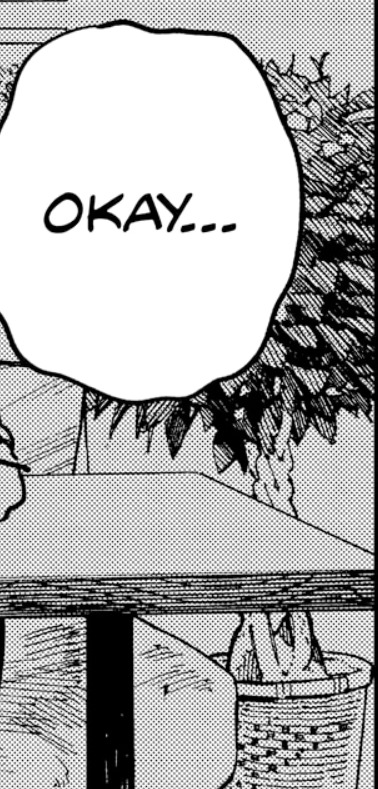
Real quick, let’s talk about this tree seen briefly in Reze’s cafe. The braided bark and downturned leaves are a dead ringer for Ficus benjamina, a common houseplant that can mean eternal love, trust, friendship, and marriage in hanakotoba. Leaving aside the marriage bit, I think this tree could be expressing the strong infatuation Denji feels for Reze in this moment, as she has just asked him out on a date.
With that, we’ve arrived at the final flowers we’ll be looking at today: the bouquet that Denji was never able to give Reze. Here are my guesses as to the flowers that were clear enough to identify.
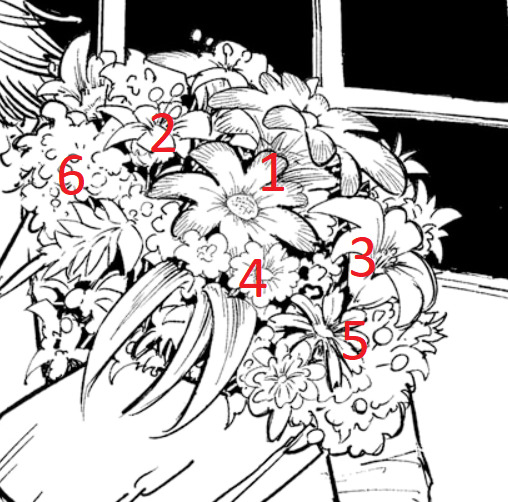

Very large flower heads, pale central disks, clearly Asteraceae, but they only have 8 and 10 ray florets respectively. I think these two are single-flowered dahlias, which mean ‘gorgeous,’ elegance, and gracefulness, but also: capriciousness, and betrayal—which is probably what Denji was feeling in the moment.
Spotted lilies, probably Lilium auratum or some hybridization thereupon: ‘love and beauty that is unadorned and down-to-earth.’ That sentiment feels very country mouse to me.
Pale, unspotted lilies: purity and dignity if white, vanity if pink, and if yellow: cheerfulness, deceit, anxiety.
This one has 8 broad, frilly ray florets—so, probably coreopsis: ‘love at first sight,’ and ‘always cheerful.’
Looks to me like tsuwabuki: ‘perseverance through adversity,’ and humility.
Some filler, likely baby’s breath, meaning: happiness, gratitude, and ‘pure of heart.’
Beyond the symbolism of the individual flowers, there’s something else noteworthy about this arrangement. When you think of a romantic bouquet, what usually comes to mind? I think of roses, tulips, lilies, and carnations, with maybe some baby’s breath as filler. Here, though, only two of those flowers make an appearance. When he went shopping for a bouquet, I think Denji went out of his way to pick one that consisted primarily of flowers that looked like the one he had given Reze, which is why most of them are Asteraceae. Rather than going with a more traditional bouquet, he chose one that he could connect to a happy memory with her.
And, that’s the last of them! To whoever's reached the end of this, thank you so much for reading. If you have your own thoughts as the identity/meaning of any plants, please feel free to chime in. I knew approximately 3 things about botany before I started all this, so I still have much to learn. I’ve also skipped over a few plants in this essay—mostly just things that were too indistinct for me to identify, but I’m also leaving Makima’s houseplants for my next essay, because I tentatively suspect that they may be related to some plants that show up in Part 2. See you then, hopefully I'll finish it soon.
13 notes
·
View notes
Text
seven sentence sunday
tagged by @hattalove @henswilsons @probieravi @thislovebuckley @trippedandfell thank u besties MWAH!! i wasn't going to do a sss to hide in shame from the fact i said last week it'd be the last sss before actors au was out and then @queerpanikkar em sent this text:

so this one goes out to u em xoxo here's the first seven sentences of actors au before i start posting tomorrow (allegedly)
Chimney’s only capable of describing What’s Inside You? in sprawling rants scattered with conflicting references. To an interviewer, he says, “It’s like, you ever see that One Direction documentary? Or Disaster Movie? So, like a mockumentary but in an apocalyptic Spaghetti Western. Like, it’s ridiculous and a parody but also totally serious and intentionally genre mixing — like, have you seen that Iranian film, A Girl Walks Home Alone at Night? That, but not.”
The journalist, when they type the interview up for publication, writes: “If you didn’t get any of that, don’t worry; you’re not alone.”
Buck, honestly, doesn’t get it, but he trusts Chimney’s filmmaking implicitly and he’s not in the movie, anyway, so he doesn’t need to. But Maddie? Maddie loves it from the second she hears Chimney stumble over a muddled description, only the second conversation she and Chimney have, absolutely missing every reference Chimney makes. And while Chimney’s willing to take Buck’s noncommittal nods and mhmms, Maddie’s insistent on making Buck get it.
It takes Maddie exactly five seconds to convince Chimney to let Maddie and Buck visit set on the first day of filming.
i'm so sure everyone's been tagged but if i'm wrong consider this ur tag
#wip games#actors au#did i write this entire 100k word fic just to drop the term spaghetti western? yes
21 notes
·
View notes
Text
Feliksball: The Spaghetti Western
Hey guys! I’m here to contribute a Polandball redraw to @wildwestaliaweek ! This is for the the free day! Yes, I know I’m late.
Looking at all the genuinely educational, high-effort posts, I’m a bit sad I can only contribute such a silly thing, but maybe next year. I also wanted to draw more from the Pierogi Western contest, but it turns out many of the jokes don’t translate well. I might try again next year though. Or maybe I might try drawing one of the other comics anyway this year, even though I’m late.
This comic is a redraw of “The Spaghetti Western” by the wonderful u/hexcodeblue! Check out the original if you like this one.
Enjoy! Sorry for the sloppy text!






#wildwestaliaweek2022#day 4#Polandball#Polandball comic redraw#hws Italy#hws north italy#hws romano#hws seborga#hws Canada#hws america#feliksball
9 notes
·
View notes
Text
Pinned post! Not made one before so this is a rough draft
This side blog is for my jumble of media hyperfixation and such (mostly movies). Here I rb artwork/stills/gifs/text posts on media.
If a media stays swirling in my brain for over a month, and has like a lot of activity on tumblr that I can rb, then i usually make another side specifically for it.
Feel free to ask for my other media sides which have lasted loooong term: Saw, Jaws, Star Trek, Fallout New Vegas, Pathologic, Disco Elysium. But not all of them are active atm! (I'll link them prob in future)
-
CURRENTLY MOSTLY POSTING:
- samurai movies
- spaghetti westerns
Also in the process or moving older posts onto new sides e.g. I caved and made my Saw & Star Trek franchise sides the in March :-)
-
Feel free to like/rb loads of stuff all at once, doesn't bother me. I'm NOT tagging my fandoms atm. Usually I do. Apologies :-(
0 notes
Text

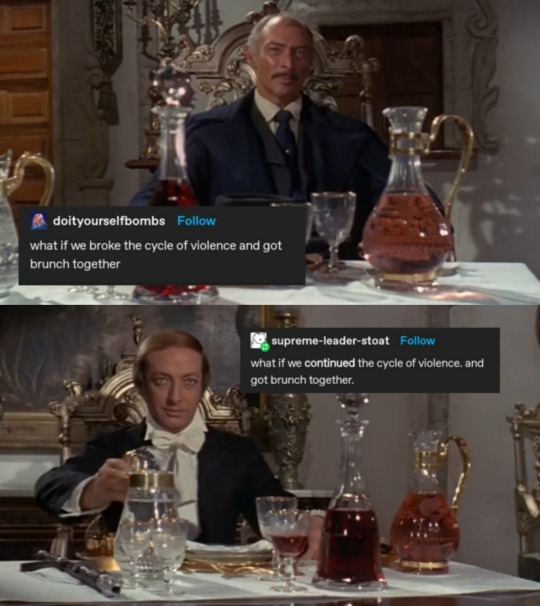

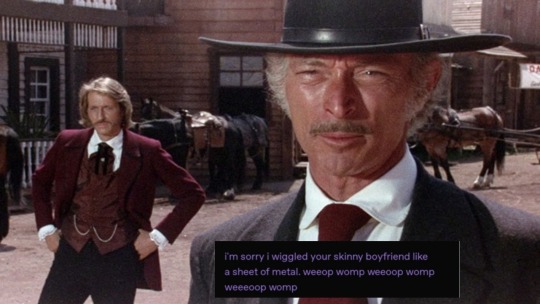
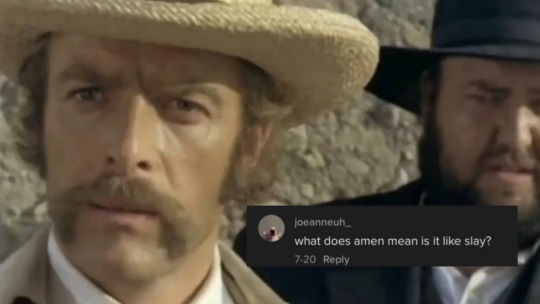
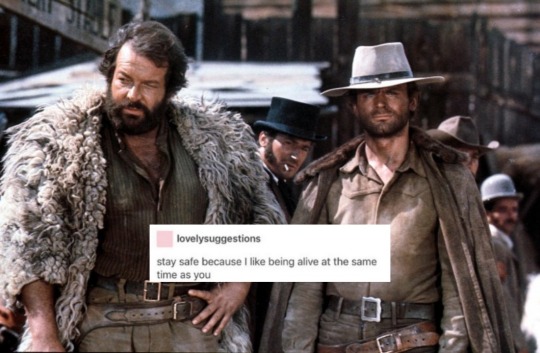
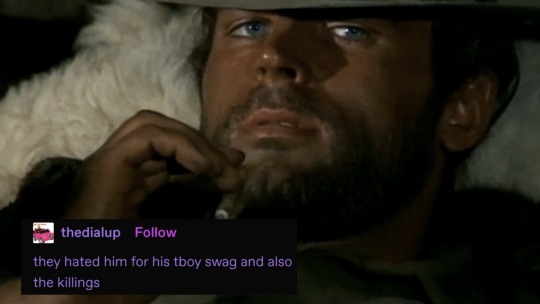
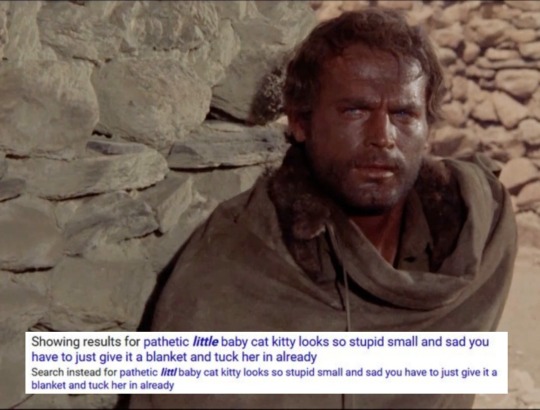
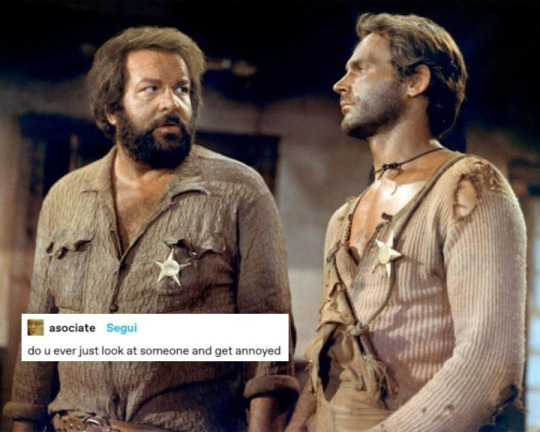
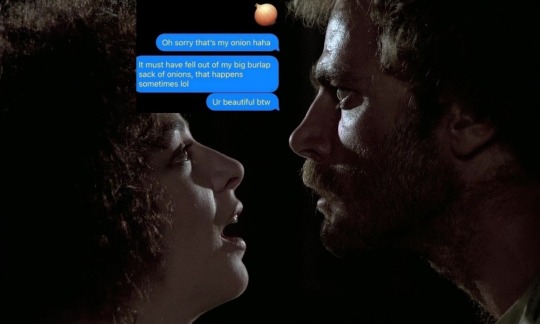
Spaghetti westerns as text posts pt. 4 maybe I'm not sure
#the good the bad and the ugly#il buono il brutto il cattivo#dollars trilogy#the man with no name#sabata#ehi amico c'è sabata hai chiuso#è tornato sabata hai chiuso un'altra volta#his name was holy ghost#uomo avvisato mezzo ammazzato parola di spirito santo#y le llamaban el halcón#god forgives i don't#dio perdona io no#ace high#i quattro dell'ave maria#boot hill#la collina degli stivali#trinity#trinità#they call me trinity#lo chiamavano trinità#continuavano a chiamarlo trinità#cipolla colt#cry onion#spaghetti westerns#spaghetti westerns as text posts
98 notes
·
View notes
Text
does anyone have that one text post that’s like spaghetti westerns are called bc italian directors made them and it said something else that was funny
1 note
·
View note
Text
might fuck about and watch Once Upon a Time in The West
#cause cowboys n that#i’m watching GBU with my mum soon so i cant watch that#i’m saving it for then#so for now#charles bronson and henry fonda baby let’s go#westerns#films#text post#henry fonda#charles bronson#once upon a time in the west#spaghetti westerns#italian westerns
20 notes
·
View notes
Text
i've been holding in this passion for the old wild west for sooo long like everytime I hear a twangy guitar and something about outlaws in the West I just get this urge to throw on a poncho and a hat and just go absolutely h o g w i l d ladies and gents
#god damn i love the whole asethetic and the potential gayness of it all#wild west#old west#yeehaw#cowboy#history#american history#outlaws#billy the kid#butch cassidy and the sundance kid#the good the bad and the ugly#westerns#spaghetti westerns#desert aesthetic#hogwild#colored text#me#my post#tumblr memes#memes
36 notes
·
View notes
Text
i just gotta say ... the brass in the instrumentals that play when u fight as john is SO sexy and will not cease to make my pulse rise
#AHAGSHAHSHA#the entire epilogue is fantastic#makes me feel SO good and nostalgic#the ost for when u play as arthur is rlly good#but hhoogh ... something abt those trumpets ...#i LOVE how spaghetti western-esc the first rdr is#thats like#my whole aesthetic#and the ost for the first game ... so good#but when they reference it in rdr2 ?#oh god .... ....... do not even get me started#im not gonna put too many tags cuz its not like ... a revolutionary post or anything#rdr2#my yeehaw posts#rdr2 spoilers#hero's talking to himself again#text
10 notes
·
View notes
Text
early Bob’s burgers was more offensive/crass/re: fkin terrible pedo/racist jokes byt like????? THEIR PACING? theyhad amazing pacing jokes like oh my god and the dialogue? it was just funnier and less bland
#bobs burgers#bob's burgers#idk its hard to name examples in a text post#but the first season#had like good ping pong dialogue and this one skit in the spaghetti western ep where there's a flashback in slow motion to linda's salad#rivalry???#oh my god#comedy gold#damn
5 notes
·
View notes
Text
Fresh Start
I’m starting this new blog as a fresh start. I called him yesterday and he didn’t answer, which is fine, but to wake up this morning to no acknowledgement of me reaching out really hurt. It stings to go every single day talking to someone, sharing even your most mundane thoughts out of the utmost comfort, to not even a courtesy text back. I had gone from December to April in complete survival mode almost, not dealing with the feelings I had because somewhere deep down I was kidding myself with the idea that we would still end up together. I would wake up and think “it’s still him, it’ll always be him”, forcing myself to remember his laugh, his dimples, the way his eyes squinted in the sun, so the next time we saw each other it would be like picking up right where we left off. I used Aidan as a coping mechanism for not being alone. I was too scared to deal with my own thoughts so I drowned them out by compromising my self worth with another person. I honestly think I liked doing something so out of character, it made me feel alive. I honestly pity Aidan now, because he was clearly hurting so bad and looking for what he had with Michaela with a complete stranger. I am proud of the fact that to this day, I haven’t shed a tear over Aidan. I knew he wasn’t worth it. He was always nothing to me, just a distraction. I mean, do you really think I could get out of a 2 year long serious relationship and develop feelings for the guy that said he was “born to be in a spaghetti western”. fat chance. I was treated like an absolute queen and the idea that I would even like a guy that did anything less is honestly ludicrous. The only feelings I have toward that situation are gratefulness and a little bit of spite. I am deeply grateful for the learning experience I got; I learned how to act in a way that will command respect from men by acting in a way that allowed me to be so deeply disrespected. I learned what it felt like to be in an open relationship, and I learned what it felt like to be in a relationship with someone that doesn’t really want to be in a relationship with you. All are valid and things I needed to know moving forward. The only spite I have was that I let him treat me certain ways, and that I genuinely lived my life believing he was out of my league. All in all, my experience with Aidan was very open shut because really it was a proxy for getting over my breakup with Shane. The whole time I was with Aidan, I would think about Shane and how he would never treat me that way (if I was even thinking in the first place). When I was with Shane, I was so aware of his feelings and energies. I was comfortable in silence. I was 100% authentic. When I was with Aidan, I was so out of my comfort zone that I would word vomit all the time, trying so hard to be this manic-pixie dream girl for him because I thought it would make him stay. I spent every waking minute comparing myself to Michaela, knowing that she’s infinitely smarter and prettier than I will ever be. But with every lesson I learned with Aidan, it taught me something about my relationship with Shane. Every negative feeling I had with Aidan, foiled into the affirmation that I wanted to be with Shane. It was basically like every time I was treated like shit, it reminded me that there was a time when I *wasn’t* treated like shit. Because of this, I really committed to the idea of getting back together. When I was with Shane, it felt different. It felt special. Extraterrestrial. It was such a pure, beautiful, and natural love. I don’t think I will ever experience it again. I want so badly to get it back. Just as quickly as things started with Aidan, they ended. And because of that I had to face the reality that I was still in love with Shane. I woke up everyday thinking about him, wondering how his day was, if he’s safe, if he has people to talk to about his mental health, how he’s holding up with the pandemic. I was so committed to getting back together the right way, so I reached out to everyone I love and respect and they all said to give him time. So I let him be. Spending everyday thinking about someone and not doing anything about it pains me. It killed me. I waited two and a half months. I wasn’t expecting him to pick up the phone and say “let’s get back together” by any means when I did choose to reach out. So his birthday rolls around and I think finally, this is my chance to reach out appropriately and just gauge where we’re at. I decided to call because it felt more from the heart and I know if I were him, a call would mean the world to me. No answer. This was fine because I had everything written down the entire day of what I planned to say. “Hey, it’s me. I just wanted to call to wish you a happy birthday. I’m sorry about the circumstances but I just want you to know no matter what happens, I’m in your corner. Happy birthday Shane”. and that was it. I shut my phone off and go to bed, not expecting anything more than a response the next day. I wake up to nothing. Nothing. So, I think it’s time I really put that idyllic dream away of being with him. He doesn’t want me. He spent the past 5 months actually getting over our relationship, not stifling feelings with some stupid e-boy who literally cannot make you laugh. So now, I’m embarking on a fresh start. I gave him the space he needed and clearly he’s moved on. I deleted my old tumblr, one of my last direct ties to him, as a signal that I’m done reaching out and going out on limbs. The ball is on his court. He has my number, but I need to shut the period of my life. He wants nothing to do with me and I guess I have to want the same thing. I need to work on myself, throw myself into things I’m passionate about. Which is why I’m starting this new blog. I’m creative, so I’ll be posting projects I work on. I hate my body, making me a bullimist, so I will also be posting about that lol. But from this point forward I’m posting about them for my own enjoyment and development, not as a cry for help. I can want him forever but I will not need him forever. Shane, I still, and will always, love you. I’ve made mistakes and regret hurting you every day. But I love you enough to move on and respect your space. Right now I’m focusing on me, and coming into a person that I hopefully won’t wince at when I see my reflection. Here’s to new beginnings I guess.
Always, P
1 note
·
View note
Text
@teaandinanity replied to your post “Hi! Im probably super late w this, but... could you please elaborate...”
I'm guessing you have to not have a Life Mage son for that ending to fire? I always end up as Regent (somehow I have never yet failed the coin toss when I get the odds to 50/50), but that sounds ADORABLE... gonna go read your guide, you probably already answered that question. XD
You can’t have a legitimate Life Mage heir, no, because then he inherits rather than Juanita, but I think you can choose to step aside for Juanita if you and the Monarch weren’t ever married, even if he is a Life Mage.
(Also, I’m pretty sure the 50/50 is flavor text; if you get the potion you have a Life Mage son.)
(more replies, sorry, this got a little unwieldy)
@twistedsinews replied to your post “ficwriter asks: 1, 2, 16, 26, 40”
<3 also spaghetti western AUs are fun, just sayin'. :D
THEY REALLY ARE
@riana-one replied to your post “2. things that motivate you, 15 hardest verse to write, 17 favorite AU...”
Stop writing poems and I will stop gushing
PSH, never, I certainly wasn’t complaining about it 😘
@ell02jen replied to your post “#WIP Wednesday”
I love the meralec one. So a another chapter would be great!!
And iamfor you. Not sure how I missed that one. It's one of my favs.
SOME DAY. For both of them! They’ve almost got stuff, they’re quite viable WIPs, so I feel confident they’ll get finished, I just never know when
@glorious-spoon replied to your post “#WIP Wednesday”
these all look FANTASTIC (although i have a soft spot for bb!BAU agent)
and I am ever so glad you do, Fuller is blushing but pleased as well 😉
@ladymatt replied to your post “#WIP Wednesday”
Not a surprise if I said, 'I Am For You' right? ;-))
no, but still appreciated! 💕
@twistedsinews replied to your post “4) What is your favourite genre to write for? , 7) When is your...”
*#archery porn fistbump of solidarity*
#archery porn forever 🏹💘🎉
@servantofclio replied to your post “15, 33, 40, 49”
I roll the OCs around in my head for a while and eventually they tell me what their names are
sometimes I manage that, and other times I have to hunt, and sometimes I just grab something as a place-holder and am eventually stuck with it and grumpy about that fact *snorts*
@glorious-spoon replied to your post “4) What is your favourite genre to write for? , 7) When is your...”
omg 'with an if in its soul sequel'?? I AM EXCITE
well. there’s been a “sequel” ever since I wrote the first one and it’s not really going anywhere so far? But I do hold out hope that I might manage it eventually
(I really need to do a proper show rewatch with an s3 rewrite specifically in mind, I think?)
@thisonelikesaliens replied to your photo “I have successfully avoided the blind box craze Until now Which means...”
omg these are so cute
@elfyourmother replied to your photo “I have successfully avoided the blind box craze Until now Which means...”
aaaaaaaaa
thanks darlings 💖 (If either of you would like a couple, do please drop me a mailing address in private? I’ve got extras)
@servantofclio replied to your post “I've followed you maybe 3 years and never regretted it”
I've followed you for SEVEN years with no regrets! :D
SAME!
@twistedsinews replied to your post “When you get this, answer with five things that make you happy, then...”
omgpuffin! :D
PUFFINS

#choice of romance#teaandinanity#ell02jen#lynne-monstr#jilly replies#twistedsinews#riana-one#glorious-spoon#ladymatt#servantofclio#thisonelikesaliens#elfyourmother#on writing#a little bit#gif
9 notes
·
View notes